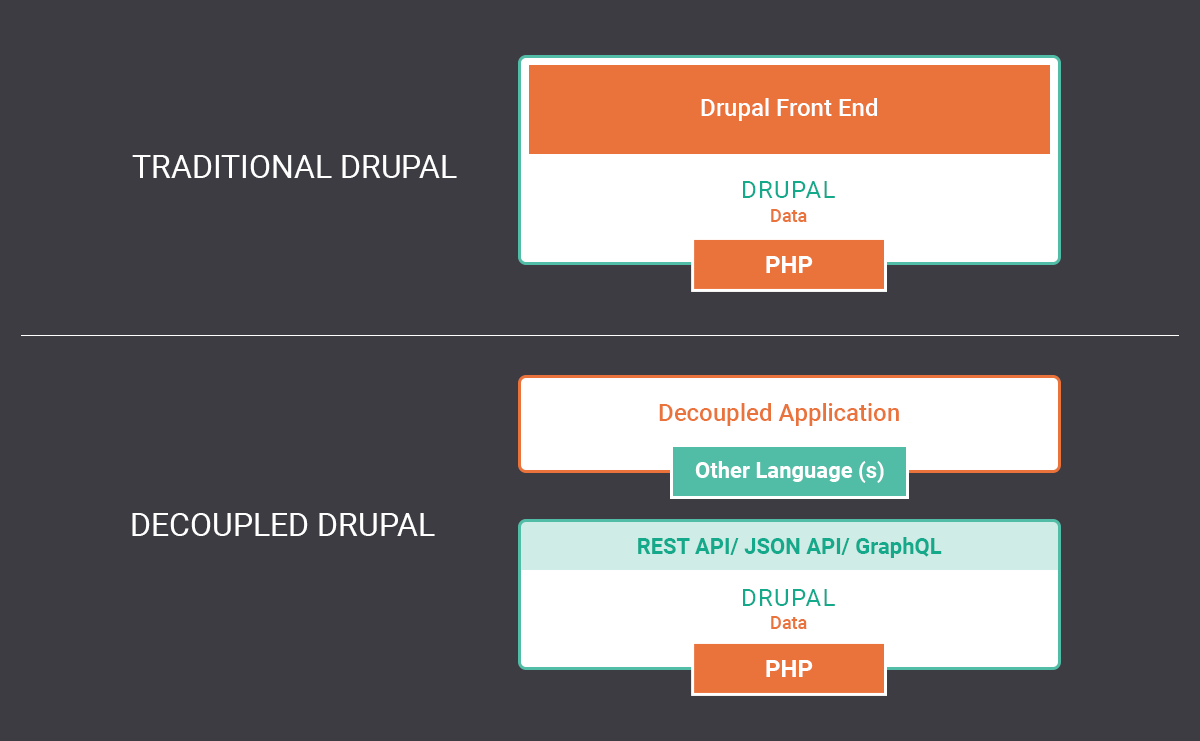As the needs of individuals and businesses keep evolving, so do Content Management Systems. A CMS facilitates the creation of a digital empire, providing all the basic infrastructure needed to create a website. A traditional or coupled CMS is where the front end and the back end are bound together. This means that the developers working in the back end and the users experiencing the front end interface are both interacting with the same system. In comparison, a headless CMS is where the front end and the back end are managed separately.
Choosing the optimum CMS for your business
Before we go on to understand when to choose headless CMS and the right way to do it, it’s important to understand the provisions of coupled CMS, the right way to choose it and when you should stick to it for all of your web development needs. The right CMS should reflect your agendas and objectives seamlessly through your content. It acts as a bedrock on which the content of your business is built upon, hence choosing the right one is crucial. Following are the points that should be kept in mind while you narrow down on a CMS -
-
Identifying the core functions that your business needs is central to the idea of selecting a CMS. A little foresight is required to avoid any glitches in the future. For instance, if your business deals with rolling out similar kinds of content at regular intervals, easy to use templates can prove to be quite beneficial in the long run, as a bulk of repetitive work is easily automated. Similarly, if you are looking to expand your website into several domains in the future, omnichannel support is what you need to look out for.
-
If your business requires several people to login and post content on your website or make changes to it, it is essential that you choose a CMS that is not too complicated in its functionality. It should be easy to use even for the non technical teams.
-
With users streaming content from several devices, the website must contain the provisions for being mobile friendly at the least. According to a Socpub survey, 57% users would never recommend a business if it had an incompetent mobile website. With UX (User Experience) gaining higher priority online, a CMS must be inclusive of the demands of its users and should also hold the potential of fulfilling those.
-
The CMS must include the analytics parameters in its interface, or include the provision to team up with Google Analytics or HubSpot for a comprehensive analysis of your business.
-
If you see your business making use of forms etc. to fill in surveys or feedback, User Interaction is another area that you need to consider while picking up a CMS. Does it provide this service? Or if not, does it enable third party integration for chats or comments
These sum up to the fact that along with user friendliness and utility tools, scalability and flexibility to adapt to various changes in the future are also essential features for a CMS in an ever changing, ever evolving world. Lastly, and most importantly, also consider how secure a CMS is and whether you can trust the system with all the data you’re uploading on it.
Benefits of traditional CMS
There are some key areas where a traditional, coupled CMS still works the best. You need to look out for one if -
-
You are a small business with limited operation that doesn’t require a bunch of diverse tools. If your content is largely monogamous and unidirectional, or if you’re in the pre alpha phase of your business and the focus is mainly on experimenting with content and greater investments aren’t supposed to be made presently, a traditional CMS will work the best for you.
-
Your primary deliverable is content, hence your team doesn’t comprise developers and coders. One of the benefits of traditional CMS is that it is easily the most convenient, as it comes loaded with all the basic tools that one could possibly need. The coupled architecture of the website increases responsiveness and bugs or issues are less likely to happen, giving you a seamless workspace.
-
Presentation or graphics aren’t the centre stage occupants in your business, and are lower on the priority list. If a compromise on the visuals doesn’t affect your brand because your focus areas lie elsewhere, go for a traditional CMS. The effort that goes into making a headless CMS functional isn’t worth your time and money in this case.
-
Lastly, budget constraints can also be a viable reason. If you resonate with point number one, ie, you’re a small business, chances are that you are bootstrapped or haven’t been funded yet. The benefits of traditional CMS include availability of the core functionalities and the subtraction of any hassles of hiring developers, and also the associated costs, hence in this scenario, it might be the one for you.
Apart from these, editing and customising page layouts with minimal technical knowledge is also a big pro in traditional Content Management Systems.
When to choose headless CMS?
However, you need to check the underlying differences in the monolithic and headless architectures. The one size fits all approach will not work for a number of businesses out there, and that will happen when a coupled CMS doesn’t turn out to be inclusive of all the needs of an enterprise. These days content has become a really diverse term, encompassing various kinds of outputs needing different delivery channels. If you’re wondering why to choose headless CMS, you can consider going for one if -
-
You are dealing with diverse content. If your business is looking to publish to different channels, the flexibility that your website needs will articulate only when you use a headless CMS. Although a traditional CMS can also publish to multiple channels, it is embedded into the very design of a headless CMS, making the delivery much faster and the final output much more user friendly. At one click, you can publish content that is accessible in the form of non web content (like a mobile app), an e-commerce website, digital signage, IoT etc.
-
You prefer a central nodal location to deliver content across channels. Any inconsistencies in the published material are ruled out as the source remains unitary, which might be a potential risk while using traditional CMS. Also, owing to these functionalities of a headless CMS, you never lose track of the market velocity and your content remains in sync with the demands of your users.
-
Your future plans include expanding into different verticals, or are, better yet, undecided. Since the technological sphere keeps changing and upgrading at the drop of a hat, it is very natural for you to want to implement bigger changes on your website down the lane. A headless CMS gives you enough space to scale your website, hence, in a way, future proofing it. So if the game plan isn’t crystal clear, a traditional system could prove to be too restrictive and you might fare better utilising these benefits of headless CMS.
-
You are an organisation with its core focus on User Experience. If your business wants to build a truly differentiated customer experience, you will benefit immensely from researching on how to choose headless CMS that fits your needs and making it your core software. With enough tools at your disposal to survey and analyse what your users want, you could go berserk with creativity. Such provisions aren’t present in a traditional CMS.
-
You have, or are, a team of developers. Headless CMS is, without a doubt, a piece of heaven for developers. One of the many benefits of headless CMS is that it is frontend agnostic, translating to custom, efficient coding to tackle any issues. Moreover, the developers aren’t limited by the tools provided in a traditional CMS and are free to tailor anything that adds to their productivity.
Keeping in mind the changing nature of the web world, CMS that initially started out as a traditional system have been branching out and expanding their use case by facilitating headless or decoupled versions of themselves.
A good example of a proficient headless CMS is decoupled Drupal. In this variant of Drupal, one can work seamlessly even with relatively low Drupal specific knowledge, and make use of multiple new functionalities like nodal content delivery, enhanced performance parameters across channels, the leeway to create custom interfaces, and align their UX to the preference of their target audience. With its backend secure and its front end agnostic, Decoupled Drupal focuses on giving you the best of both worlds, backing endless possibilities of content creation and delivery.

Challenges of headless CMS
However, before finalising one, you might want to look out for the following concerns regarding a headless CMS -
-
The simplicity of the CMS goes for a toss. With increase in tasks and technical scenarios, a headless CMS isn’t as simple to use as a coupled one, where all the tools are pre made and are at your disposal. It would not make the cut if your business requires multiple people interacting with the website on a daily basis, as it would get too complicated for most.
-
To work with a headless CMS you would need to be a developer, or have the financial capacity to hire one. Hence, if you are a small team and don’t have enough resources to allocate to developers, a headless CMS would be too far fetched of an investment. Since it requires building the front end presentation templates of the website, mobile apps, etc. working on making a headless CMS functional necessitates the need of technically proficient resources,
-
The perfectionist in you wouldn’t like the fact that you can’t see a preview of what the final content will look like while working on a headless CMS. Most marketers prefer having a beforehand idea of the visuals of the published material, and a CMS with no presentation template will pose a problem in this case.
-
Lastly, you might not need it. A flexible front end means deployment of ample time and monetary resources towards creating things that already are present in a coupled CMS. If the investment isn’t worthy enough for your business or doesn’t have sufficient ROI (Return On Investment), the challenges of headless CMS will outnumber its benefits.
Conclusion
The trajectory at which you plan your business to progress is something that should determine crucial Ifs and Buts of choosing the perfect Content Management System. Your business needs to go headless only if it fits in the path you’ve chosen, and even then, at your predetermined pace.
Subscribe
Related Blogs
Trek n Tech Annual Retreat 2025: A 7-Day Workcation of OSL

OSL family came together for the Trek n Tech Annual Retreat 2025, a 7-day workcation set amidst the serene beauty of…
Exploring Drupal's Single Directory Components: A Game-Changer for Developers

Web development thrives on efficiency and organisation, and Drupal, our favourite CMS, is here to amp that up with its…
7 Quick Steps to Create API Documentation Using Postman

If you work with API , you are likely already familiar with Postman, the beloved REST Client trusted by countless…




